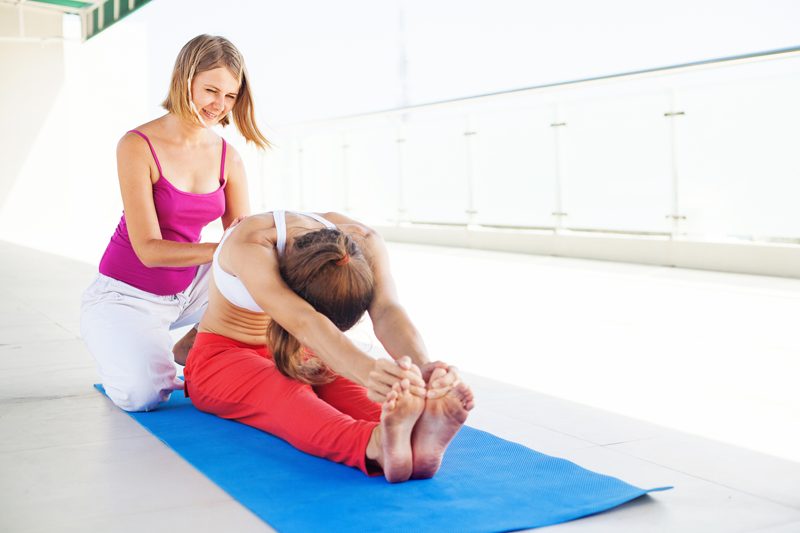Lordosis is a condition that causes an exaggerated curve in the lumbar vertebrae. If left untreated, this can lead to excessive pressure on the spine as it tries to support the head. After a while, this can cause pain and discomfort in the back and shoulders. Thankfully, yoga can be used to reduce the curvature and provide the sufferer with relief. For best results, there are four main areas you should target. These are strengthening the core, stretching the hip flexors, lower back, and glutes. In this article, we explore yoga poses to help lordosis in more detail. Before getting started, pick up a flexible pair of yoga pants that allow your body to move.
Seated Forward Bend
Perfect to start with, Seated Forward Bend stretches the back and teaches us how to breathe through uncomfortable positions. To practice the asana, begin seated with your legs closed and your hands by your sides. Lift your chest and lower your upper body towards your legs. Engage your abdominals and imagine your stomach moving toward your thighs. You are in Seated Forward Bend. If you can’t bend all the way, don’t worry. As long as you feel a stretch through your upper and lower back, the posture is doing its job.
Chair Pose
Providing a deep stretch in the lower back, Chair Pose is another great posture for sufferers of lordosis. To practice the asana, stand tall with your big toes together. Take a deep breath in and raise your arms above your head, pointing your fingertips toward the ceiling. Draw both shoulders back as you lengthen your neck. As you exhale, bend your knees and begin to lower your bottom down and back, almost as if you’re sitting on a chair. Each time you breathe in, extend your spine a bit more. With each breath out, deepen the stretch by lowering your bottom further toward the mat. You are in Chair Pose. Hold the posture for 30 seconds whilst breathing deeply.
Boat Pose
To practice Boat Pose, sit down on the floor with your legs straight. Next, place your hands on the floor just behind your hips, ensuring that your fingertips are pointing towards your feet. Press your palms firmly into the floor as you straighten your arms. Keeping your back straight, gently lean back and lift your feet off the ground. Your shins should now be parallel to the floor. As you lift your chest, lengthen the front of your torso. Finally, extend both arms forward until they are in line with your shoulders. You are in Boat Pose. Hold the pose for 30 seconds whilst breathing deeply. For best results, draw your chin into your chest. This action brings the base of the skull away from the neck and allows the body to enjoy a deeper stretch.
Pigeon Pose
To practice Pigeon Pose, begin by standing tall. Next, hinge at the waist and lower your torso towards the mat until your body forms a triangle. From this position, extend your right leg back behind you. Bring your right knee to your right wrist and move your foot to touch your left wrist. Your shin should now be perpendicular to the front edge of your mat. You are in Pigeon Pose. Hold the asana for around 30 seconds before repeating on the other side.
Cobra Pose
To practice Cobra Pose, lie down on your mat with your stomach touching the ground. Lengthen your legs, keeping the tops of your feet on the floor. Next, place your hands flat on the ground, resting them directly under your shoulders. Gently draw your elbows back into your body whilst pressing your thighs and the tops of your feet into the ground. Stay in this position for a couple of seconds and take a few deep breaths. When you’re ready, lift your chest off the ground by straightening both arms. Finally, press your tailbone firmly into the floor and engage your buttocks. You are in Cobra Pose. For best results, draw your shoulder blades towards your back and distribute the stretch evenly throughout the spine. Hold the posture for around 30 seconds before releasing the backbend and lowering yourself back down to the floor.
Plank Pose
Used to strengthen the core, Plank Pose is another great pose for relieving lordosis. To practice the asana, begin on all fours. Tuck your toes under and lift your legs up off the ground. Slide your feet back until your body forms a straight line from your head to your feet. Finally, engage your abdominals and draw your shoulder blades down and back. You are in Plank Pose. Keep your abdominals engaged to hold the position for as long as possible. For best results, build up your strength by practicing the exercise daily.
Wide-Legged Straddle
Wide-Legged Straddle is a deep hip opener. To practice the asana, sit down on your mat with your legs apart. Once you’re comfortable, spread your legs as wide as possible. Keeping your knees straight and toes pointing towards the ceiling, place your hands out in front of you. Next, slowly lower your upper body towards the mat. If necessary, rest your hands on the floor for support. Finally, ensure that your back is straight. You are now in Wide-Legged Straddle. Hold the asana for around 15 seconds before releasing the stretch and repeating the process. For best results, repeat the exercise between 5 and 10 times per session.
In Summary
For long-term relief, practice the above yoga poses to help lordosis. To avoid injury, practice on a comfortable mat and to wear the right clothing. If you choose to practice outside, remember to wear a yoga cap a good-quality SPF.

